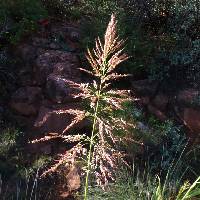|
|
|
|
Family: Poaceae
Johnsongrass
[Andropogon halepensis (L.) Brot.] |
Mary E. Barkworth Plants perennial; rhizomatous. Culms 50-200 cm tall, 0.4-2 cm thick; nodes appressed pubescent; internodes glabrous. Ligules2-6 mm, membranous, conspicuously ciliate; blades 10-90 cm long, 8-40 mm wide. Panicles 10-50 cm long, 5-25 cm wide, primary branches compound, terminating in rames of 1-5 spikelet pairs; disarticulation usually beneath the sessile spikelets, sometimes also beneath the pedicellate spikelets. Sessile spikelets bisexual, 3.8-6.5 mm long, 1.5-2.3 mm wide; calluses blunt; glumesindurate, shiny, appressed pubescent; upper lemmas unawned, or with a geniculate, twisted awn to 13 mm; anthers 1.9-2.7 mm. Pedicels 1.8-3.3 mm. Pedicellate spikelets staminate, 3.6-5.6 mm; glumes membranous to coriaceous, unawned. Caryopses not exposed at maturity. 2n = 20, 40; several dysploid counts also reported. Sorghum halepense is native to the Mediterranean region. It is sometimes grown for forage in North America, but it is considered a serious weed in warmer parts of the United States. It hybridizes readily with S. bicolor, and derivatives of such hybrids are widespread. The annual Sorghum almum Parodi, which has wider (2-2.8 mm) sessile spikelets with more veins in the lower glumes (13-15 versus 10-13) than S. halepense, is one such derivative. The Morton Arboretum Perennial rhizome-bearing herb 0.5 - 2.5 m tall Leaves: basal and along culm, with ligules that are 2 - 6 mm long, membranous, and lined with hairs along the margins. Blades are 10 cm - 0.9 m long and 8 - 40 mm wide. Inflorescence: terminal, branched (panicle), 10 - 50 cm long, 5 - 25 cm wide. Primary branches are whorled and end in spikes with one to five spikelet pairs. Fruit: a caryopsis that is not exposed when mature. Culm: 0.5 - 2 m long, 0.4 - 2 cm across, with appressed-hairy nodes and hairless internodes. Spikelets: either stalkless or stalked. The stalkless spikelets are bisexual, 3.8 - 6.5 mm long, 1.5 - 2.3 mm wide, and compressed on the back. Stalked spikelets male, well-developed, 3.6 - 5.6 mm long. Glumes: of stalkless spikelets shiny, hardened, and appressed-hairy, the lower glume compressed on the back and rounded near the base, the upper glume with two longitudinal ridges. Glumes of the stalked spikelets are membranous to leather-like. Florets: borne on stalkless spikelets have lower florets reduced to transparent lemmas, upper florets with anthers 1.9 - 2.7 mm long and transparent lemmas that are unawned or have a bent and twisted awn to 13 mm long. Similar species: Sorghum bicolor is an annual or short-lived perennial that lacks rhizomes and often has exposed mature caryopses. Flowering: early July to late September Habitat and ecology: Introduced from the Mediterranean, this species grows near grain elevators and in sandy road shoulders after a recent seeding (likely being in the seed mix). This species is a problem weed in the south, but is most likely not cold hardy here. Occurence in the Chicago region: non-native Etymology: Sorghum comes from the plant's Italian name, sorgo. Halepense means "from Aleppo, Syria."
Author: The Morton Arboretum Vascular Plants of NE US and adjacent Canada Robust perennial to 1.5 m, colonial by long rhizomes; lvs elongate, 1-2 cm wide; panicle 1.5-4 dm, open, its main axis glabrous or scabrous; sessile spikelet silky, 4-6 mm, the pediceled one staminate (or neuter), glabrous, slightly longer; awn 1-1.5 cm; 2n=40. Native to the Mediterranean region, cult. for forage, escaped and well established as a weed especially in the s. part of our range, but also n. to Mass. and Mich. (Holcus h.; S. miliaceum) Under some conditions the plant becomes poisonous through the production of prussic acid. Johnson-grass is the result of hybridization with cult. sorghum. Gleason, Henry A. & Cronquist, Arthur J. 1991. Manual of vascular plants of northeastern United States and adjacent Canada. lxxv + 910 pp. ©The New York Botanical Garden. All rights reserved. Used by permission. |





